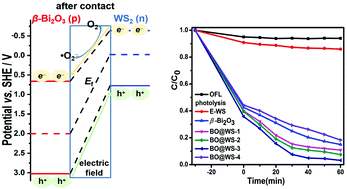Hollow core/shell β-Bi2O3@WS2 p–n heterojunction for efficient photocatalytic degradation of fluoroquinolones: a theoretical and experimental study†
Abstract
In this work, theoretical calculations were firstly carried out for the rational design of a heterojunction photocatalyst. As predicted, the photogenerated electron of WS2 transfers to the conduction band of β-Bi2O3, while the photogenerated hole of β-Bi2O3 transfers to the valence band of WS2, thus efficiently separating the photogenerated electron–hole pair. Solid structural characterization proved that WS2 nanosheets were well loaded on the surface of β-Bi2O3 hollow spheres. The formation of a heterojunction significantly improves both the intensity and range of visible-light harvesting, along with the charge separation ability of the photogenerated carriers, as confirmed by UV-vis diffuse reflectance spectroscopy, photoluminescence spectroscopy, photocurrent density measurements and electrochemical impedance spectroscopy. Moreover, the photocatalytic degradation of fluoroquinolones (FQs) (ofloxacin (OFL), ciprofloxacin (CIP), and norfloxacin (NOR)) by the obtained photocatalyst was measured under visible-light irradiation. The 8 wt% WS2-coated β-Bi2O3 photocatalyst exhibited superior removal rates for OFL, CIP and NOR, which were 2.32, 2.01 and 1.71 times greater than those of β-Bi2O3 under the same conditions, respectively. The enhanced photocatalytic performance was attributed to the synergistic effect derived from the p–n junction structure and the core/shell morphology, which enhance the visible-light harvesting capacity, accelerate the separation and transfer of photogenerated charge carriers, and enlarge the specific surface area. The removal efficiency was optimized by modifying a series of parameters including contaminant concentration, photocatalyst dosage, and additive species. In general, this work presents a facile approach for the rational design of p–n core/shell heterojunction photocatalysts, with potential applications in environmental remediation.



 Please wait while we load your content...
Please wait while we load your content...